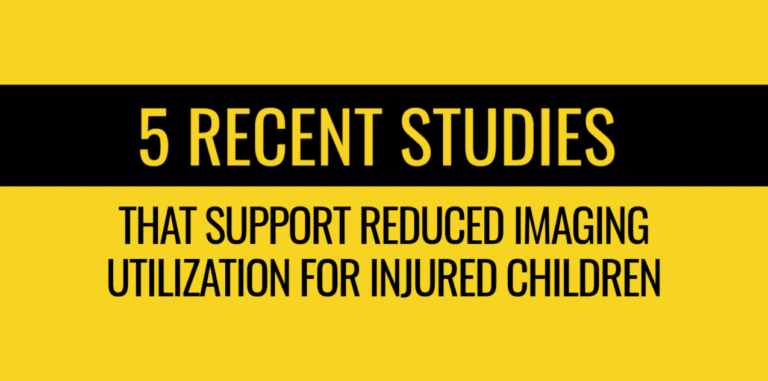The Orange Book encourages trauma providers to minimize the use of ionizing radiation for pediatric patients. Five recent studies that weigh the risks and benefits of imaging utilization could help trauma teams reduce CT use for injured children.
The studies were analyzed by the staff of JournalFeed, a website that provides daily peer-reviewed summaries of current articles in emergency medicine.
1. Pan-scan shows no mortality benefit for children with blunt injury
Researchers at Albert Einstein in New York used the National Trauma Data Bank to study 42,912 children with blunt trauma who received an emergent CT scan. The team used propensity score weighting to compare patients who received whole body CT with patients who received selective CT.
“Whole body CT vs selective CT in children with trauma did not result in mortality benefit,” JournalFeed notes. “This large, retrospective study with propensity matching suggested that any additional injuries found on pan-CT may have been either not life-threatening or did not change management to produce mortality benefit.”
Read the entire summary: Does Pan-Scan Benefit Pediatric Trauma Patients?
2. Cancer risk of chest CT outweighs likelihood of discovering aortic injury
A team at Boston Children’s Hospital analyzed a large database of pediatric trauma patients treated at U.S. children’s hospitals. Out of 311,850 admitted patients, 124,909 children received a chest CT but only 46 were diagnosed with thoracic aortic injury.
According to JournalFeed, chest CT’s positive diagnosis rate for aortic injury is 1.8/10,000, which is much less than estimated rates of cancer risk: “Obtaining a screening chest CT for thoracic aortic injury poses a higher risk of cancer than the likelihood of identifying an aortic injury in injured children.”
Read the entire summary: Chest CT Risk vs. Aortic Injury Risk In Children
3. If vomiting is the only symptom, it is safe to forgo CT for children with head injury
In the PECARN head injury rule, vomiting in combination with other defined symptoms is a predictor of clinically important TBI. But what if vomiting is the only symptom? To find out, a group of Australian researchers performed a secondary analysis of 19,920 children enrolled in the Australasian Paediatric Head Injury Rule Study.
“In pediatric patients with blunt traumatic head injury, none had clinically important traumatic brain injury (ciTBI) or significant injury on CT (TBI-CT) if the only symptom was vomiting <3 times,” JournalFeed summarized. “It was still extremely low if isolated vomiting 3 or more times: 3/1000 for ciTBI and 6/1000 for TBI-CT.”
Given the rarity of significant brain injury in children who present with head injury and isolated vomiting, observation without immediate CT appears to be an appropriate management strategy.
Read the entire summary: Pediatric Head CT — Does Vomiting Matter?
4. Children with isolated costal margin tenderness unlikely to benefit from CT
Researchers at UC Davis and the University of Washington performed a retrospective database study of children with isolated costal margin tenderness (CMT). They defined isolated CMT as tenderness at the costal margin without abdominal or thoracic wall trauma, abdominal tenderness or pain, decreased breath sounds, or vomiting.
Out of 9,174 children in the study, 1,090 had non-isolated CMT and 177 had isolated CMT. While 17.2% of children with non-isolated CMT had intra-abdominal injuries (IAI), no children with isolated CMT had IAI. However, the difference was not statistically significant.
“Pediatric patients with isolated costal margin tenderness (CMT) on exam are very unlikely to have underlying intra-abdominal injury and also unlikely to benefit from CT,” JournalFeed concluded. “But make sure there are no other signs of abdominal injury.”
Read the entire summary: Isolated Costal Margin Tenderness in Kids — CT or Not?
5. Consider the PECARN rule to avoid CT for children with blunt abdominal trauma
The PECARN rule for blunt abdominal trauma (BAT) is designed to identify children at very low risk of clinically important intra-abdominal injury. The rule includes seven criteria:
- no evidence of abdominal wall trauma or seat belt sign
- GCS score greater than 13
- no abdominal tenderness
- no evidence of thoracic wall trauma
- no complaints of abdominal pain
- no decreased breath sounds
- no vomiting
A group of researchers at Vanderbilt University recently used trauma registry data to test the sensitivity of the PECARN rule for BAT. Out of 5,743 patients, 133 had clinically important intra-abdominal injury. Only one patient out of this subset would have been characterized by the rule as very low risk.
According to JournalFeed providers should consider using the PECARN BAT rule, but they need to be aware of the limitations of this study. “The PECARN rule for blunt abdominal trauma in children had high sensitivity, 99%, in this retrospective review. A prospective validation study would give us greater confidence to use this in clinical practice.”
Read the entire summary: PECARN Abdominal Trauma Rule Performs Well
This article was produced in partnership with JournalFeed, a website that provides daily peer-reviewed summaries of current articles in emergency medicine. JournalFeed offers daily and weekend-only newsletter options. To subscribe, click here.

